
Who else wants a 5-star
Hyper-V backup and
recovery solution?
Slash downtime to near zero with Rapid VM Recovery,
easily restore and move VMs, and achieve granular
file restore with a few clicks.

Now you can have a complete Hyper-V backup software solution. Loaded with features to help make restores and recoveries fast and simple, it pays for itself with reduced downtime. Best of all, our pay per host licensing delivers substantial cost savings.
Instant guest VM recovery:
- Boot a VM in disaster recovery scenarios, reducing downtime to near zero.
Granular restore:
- Search, browse and restore files within a guest, directly from the host's backup.
Documentation tool:
- Hyper-V Config Reporter will document the configuration of the Hyper-V machines, making it easier to restore or move to a different host.
Exchange granular restore integration:
- Also compatible with our Exchange Granular Add-on, for when Exchange runs in a VM guest.
BackupAssist Classic already provides, out of the box:
- Back up Hyper-V Guests
- Full VM recovery for Hyper-V Guests
However:
Using conventional recovery methods requires copying a VM's VHDX files from the backup - taking hours for a recovery.
WHAT'S IN IT FOR YOU
Effortlessly handle these common data loss / data recovery scenarios:

Slash downtime with Rapid VM Recovery.
With other Hyper-V Backup software solutions, a recovery can take hours, requiring you to re-image your machine from backup.
Our Rapid VM Recovery bypasses this. It allows you to boot your VMs directly from backup, slashing downtime to nearly zero.

Restore files within VMs easily.
When you back up your Virtual Machines, you'll just see large .vhdx files when you browse your backup. How do you get to the files within each VM's virtual disk?
Our enhanced restore console lets you search for and browse files of your guests, directly from the host backup. And the original backup remains untouched

Document VM setup easily.
Experienced administrators know that documenting each VM's Hyper-V setup is critical if you want to recover or migrate your VM.
Our Hyper-V Config Reporter automatically generates the documentation you need to recreate a VM perfectly.
Zero effort required.

Save money: licensed per host
You probably moved to Hyper-V to achieve cost savings. But the costs start adding back if you use a backup product that licenses per-socket or per-VM!
BackupAssist Hyper-V Advanced Add-on is licensed per host. Back up and recover unlimited VMs - no fine print.
HOW IT WORKS
1. Rapid VM Recovery
Under the Hood: The Hyper-V Advanced Add-on handles the heavy lifting.
During your emergency recovery…
The magic happens under the hood:
> We create a differencing disk on top of the backup VHDX files, to enable us to write changes to the VM's virtual disks while preserving the original integrity of the original backup.
> We then apply the necessary changes to get the VM to a bootable state.
> We fire up the VM straight from backup. All data changes are written into the differencing disk, so the original backup is always preserved.
Integrates into the Restore Console
Our restore console will:
> Choose a time for scheduled maintenance, where you can copy your VM back to your primary disk instead of running it from backup.
> Easily perform a Virtual-to-Virtual BMDR
> You can choose to include, or exclude, all the changes that were made to the VM while it was running in Rapid VM Recovery mode.
Our recommendation:
> Use this in emergency situations, where you need to instantly recover a VM to avoid downtime.
> As soon as is practical, schedule downtime to perform a full recovery back to your regular system.
What you see: Using Rapid VM Recovery is a piece of cake.

1: Click Rapid VM Recovery
Requires the Hyper-V Advanced Add-on, which is unlocked on the BackupAssist Recover tab
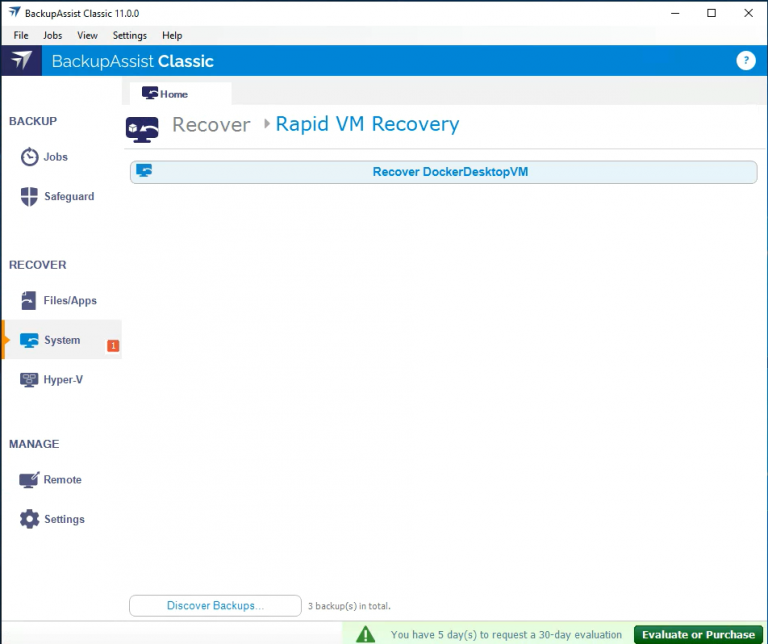
2: Click the backup job of the VM
Hyper-V guests backed up by System Protection jobs can be rapidly recovered, and these jobs are listed for selection

3: Set a location to save VM data changes to
While the Rapid VM is running, all data changes are saved and used when a Full VM Recovery of the VM is performed
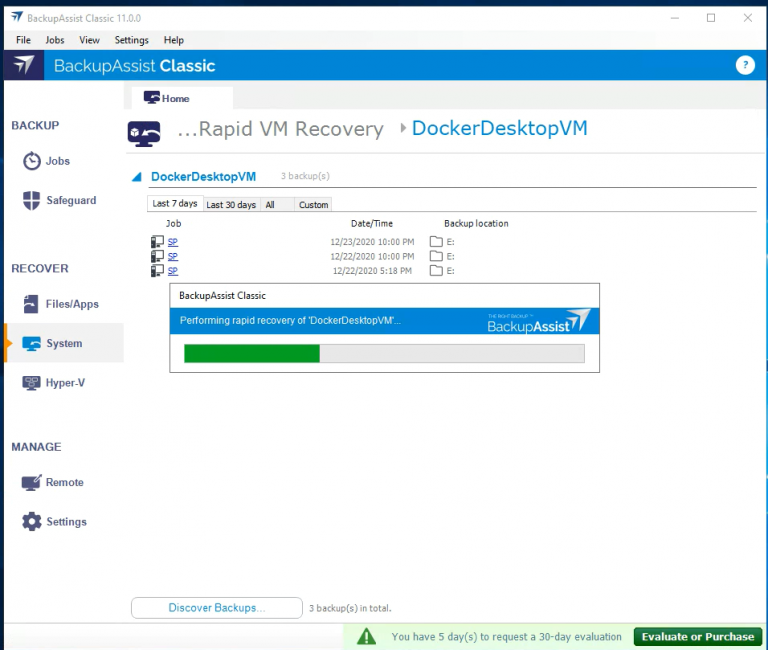
4: Click the appropriate backup
From the list of backups for the selected job, click the one you want to use and the Rapid VM Recovery will start in less than a minute

5: Click Perform Full Recovery
With business continuity achieved, you can run a Full VM Recovery of that VM at a convenient time. All data changes will be included
2. Granular restore for files
Under the Hood: Our Hyper-V backup software performs additional operations on the host, to make future restores easy.
A little extra work at the time of your backup…
> At the end of each backup, BackupAssist will generate catalog files that index all the files on each Guest VM that was backed up.
> These catalog files are stored along with the backup, and also saved to the Hyper-V host.
> It doesn't matter if the backup is an image or file-based backup, nor does it matter the backup destination - it works the same way.
… so when you restore, it's easy!
> The Restore Console uses those catalog files, making it easy for you to browse and search for your data.
> When you start the restore, BackupAssist will open the appropriate backup VHDX file and then the VM VHDX file to retrieve the selected data.
> No modifications are made to the backup file, so the integrity of the original backup is preserved.
What you see: Using Hyper-V Granular Restore is a easy and intuitive.

1: Click Files inside Hyper-V Guests
Requires the Hyper-V Advanced Add-on, which is unlocked in the BackupAssist restore tab
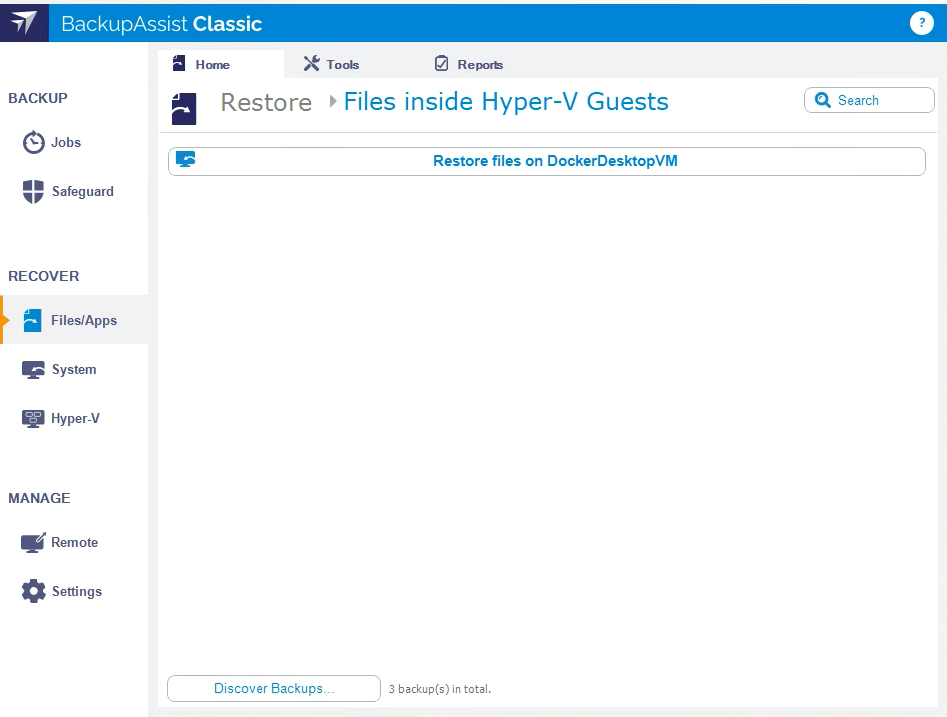
2: Click the backup job of the VM
The backup job for each Hyper-V guest is listed. These can be System Protection, File Protection or File Archiving jobs
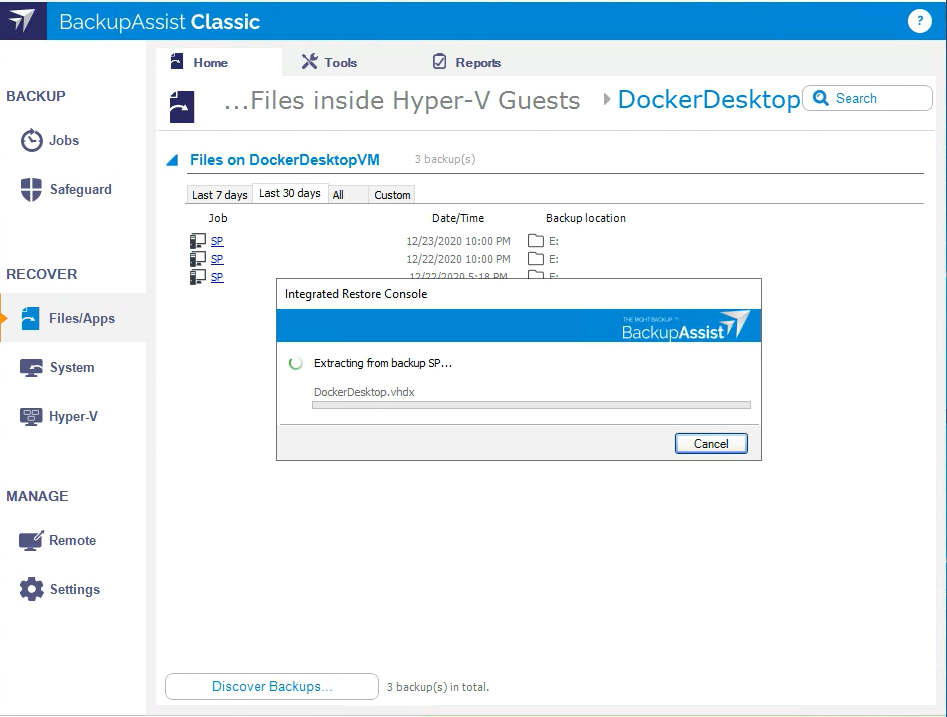
3: Click the appropriate backup
All backups created by the job are listed. Select a backup and it will be opened in the restore console
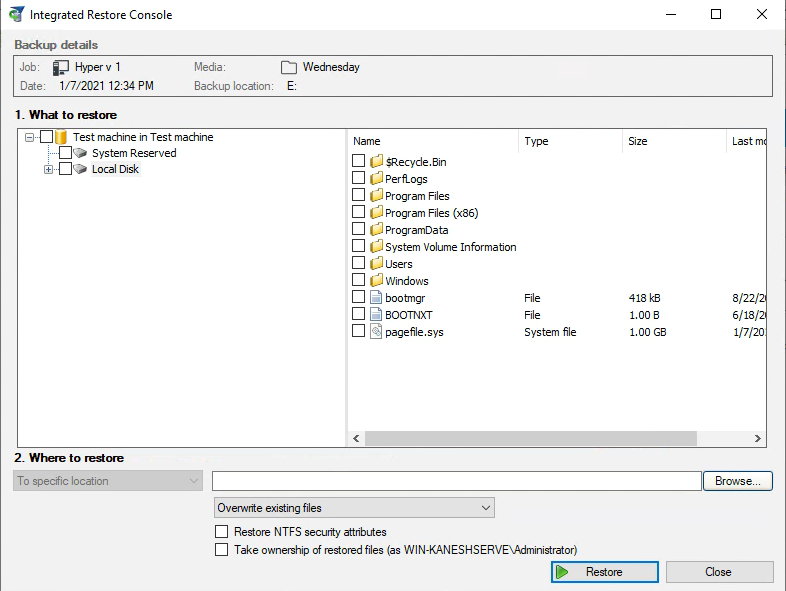
4: Set your restore options
The BackupAssist Restore Console allows you to select files and set the restore destination and overwrite options
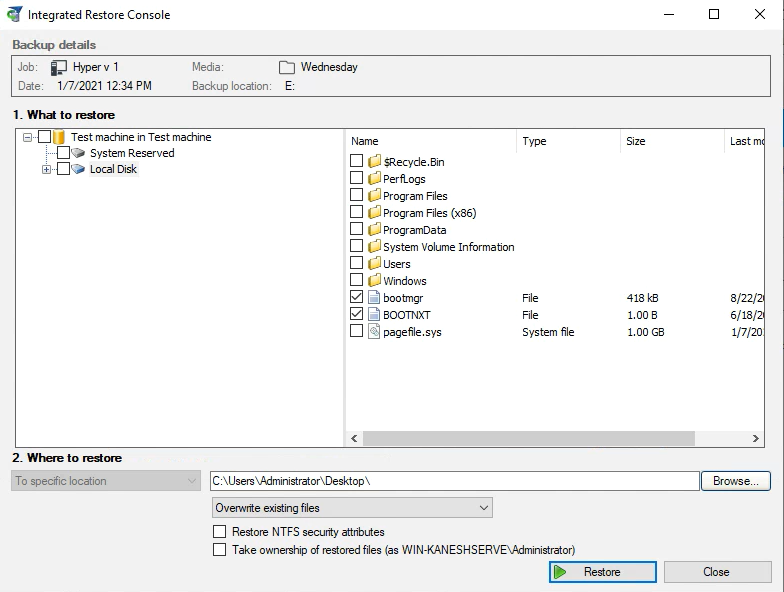
5: Select the files to restore
Use the Restore Console to browse through all the files in the VM, and select the files and folders that you want to restore

6: Restore the files
Select Restore and the files will be restored to the chosen destination while the progress is displayed
Hyper-V Config Reporter
Under the Hood: The dreaded task of documentation just got a whole lot easier.
Whenever you make configuration changes, we recommend rerunning the reports.
> Internally, our Hyper-V Config Reporter will query the Hyper-V system to obtain details about the setup configuration.
> It then generates the reports on demand.
> Because our software talks straight to Hyper-V, there are no mistakes or omissions due to human error.
What you see: Using Hyper-V Config Reporter is simple and fast.

1: Run the Hyper-V Config Reporter
The Hyper-V Config Reporter is run from the start menu, and the report can be saved or printed
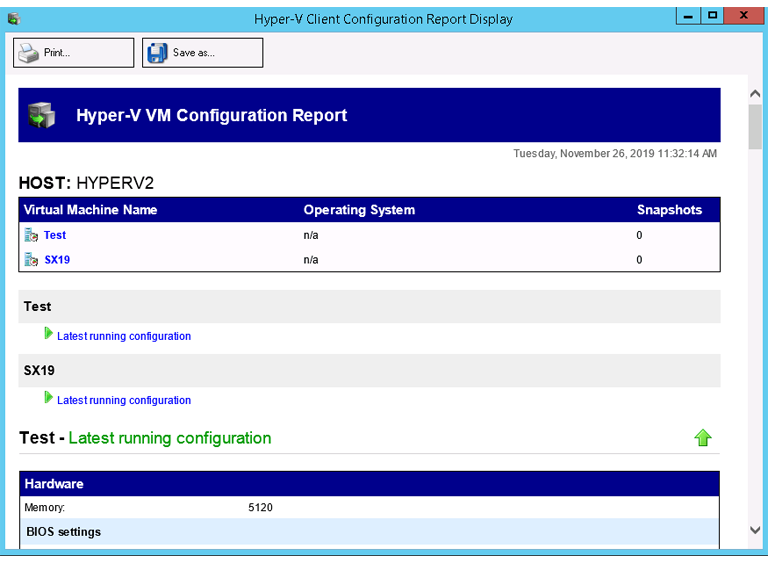
2: View the configurations
The Hyper-V Configuration Report has a section for each VM, which is bookmarked at the top of the report.

3: View each VM
Each section shows a VM's Hardware, including BIOS settings and controllers, and VM Management information.

4: View the Security Information
If you selected 'Include Host Security Report' there will be a section listing the Hyper-V Service's role definiations
FREQUENTLY ASKED QUESTIONS
A Rapid VM Recovery is a useful emergency option to get a machine running immediately. It generally only takes two minutes to have a fully functioning Virtual Machine running from your backup.
However, we do not recommend running this for longer than you must. It's always best to keep your backups separate from your production environment. The longer you run from your backup hardware, the more chance you have of suffering further problems (whether it is from ransomware, or hardware failure) - and that could compromise your backups.
There is no licensing limit built into our Hyper-V backup software. As far as we're concerned, you can back up as many guests as you wish with a single install of BackupAssist Classic!
However, at some stage you will run into practical limits caused by hardware. That's the topic for the next frequently asked question.
The main problem we see when backing up a large number of hosts is VSS timeouts. The problem can be dealt with quite easily, but let's look at why it happens.
The cause: when a backup starts, BackupAssist Classic will send the appropriate signal to Hyper-V to get all VMs into a consistent state. In English, that means, “finish any in-progress transactions and flush any pending writes to disk, so we can start a backup”.
If you have too many VMs on one machine, that means the host's disks can go crazy, as each VM commits its changes to disk.
If this process cannot happen within a timeout period (default is 20 minutes), then the backup aborts.
The solution: instead of backing up all your VMs at the same time, set up two or more backup jobs set to run at different times, and split your VMs among those jobs.
Absolutely there:
- configuration tips on how to configure our Hyper-V backup software, and
- ways you can set up your Hyper-V environment to make recoveries easier.
